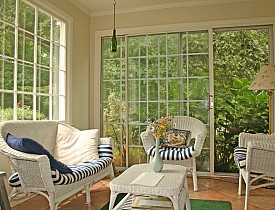Harnessing Passive Solar
 If you have large, south-facing windows, you may already be using solar power in your house. If the windows turn a room into a sauna in the summer and a fridge in the winter, some touchups can lower winter heating bills and minimize summer heat.
If you have large, south-facing windows, you may already be using solar power in your house. If the windows turn a room into a sauna in the summer and a fridge in the winter, some touchups can lower winter heating bills and minimize summer heat.
Passive solar design, also known as climatic design, effectively uses abundant solar power without panels or other mechanical systems. Passive solar principles should be applied to new, energy-efficient construction. Simple retrofits can also boost the passive solar capacity of any home, with windows, walls or dedicated passive solar rooms. Also consider dark, heat-absorbing floors (particularly stone, concrete, or other masonry) to make any passive solar design more efficient.
Windows
The term direct solar gain simply means window placement and design. In warm climates, the largest windows should be on the north side to minimize heat gain in summer months but still allow plenty of natural light. In cold climates, large and insulating windows should be on the south side of the house. They will draw heat during the winter, and are easily shaded with awnings, trees and bushes, or window coverings in the summer.
EnergyStar-rated windows and many other models come with a label that lists four numbers. The U.S. Department of Energy recommends fitting south-facing windows with double- or triple-pane glass that has a solar heat gain coefficient (SHGC) of at least 0.6, a U-factor of less than 0.35 and a high visible transmittance (VT) to allow in plenty of light and reduce the need for artificial lighting. Also keep windows clean inside and out to maximize the incoming sunlight.
Walls
Indirect solar gain through specially designed walls is a little more complicated and costly, but is an effective way of using solar heat after dark.
A Trombe wall is the most popular indirect passive solar item. It typically consists of an insulated layer of glass outside a dark, thick masonry wall. The glass helps the 8- to 16-inch wall absorb and trap the heat.
The wall slowly radiates the absorbed heat into the room over several hours it radiates into the living space. An 8-inch-thick wall will absorb and radiate noontime heat at 8 p.m. because masonry transfers heat at an average rate of 1 inch per hour.
New Trombe walls also have top and bottom vents that allow hot air to escape from the top during the summer. If a door or window is open across the room, it can create a cooling current by drawing in cooler air from the bottom of the Trombe wall.
Sunrooms
Isolated gain is the other type of passive solar heat. A solarium or sunroom has a glass wall designed to trap the sun's heat and warm a specific space that is somewhat removed from the main house space. The room will draw in plenty of winter warmth, but is harder to regulate than more traditional windows. They may not be ideal in some hot climates because they get too hot in the summer, and don't offer much of an advantage in the winter.
Passive solar energy can be used without solar panels or other devices. It simply maximizes the sun's winter heat gain and minimizes summer heat loss with windows, walls and floors.
Looking for a Pro? Call us (866) 441-6648

Electrical Average Costs
Electricians Experiences

Hiring A Great Landscaper Was Almost Too Easy, Even Long Distance

Contracted A Large Tree Trimming Job For A Reasonable Price



